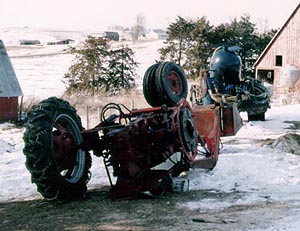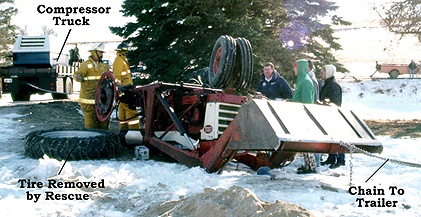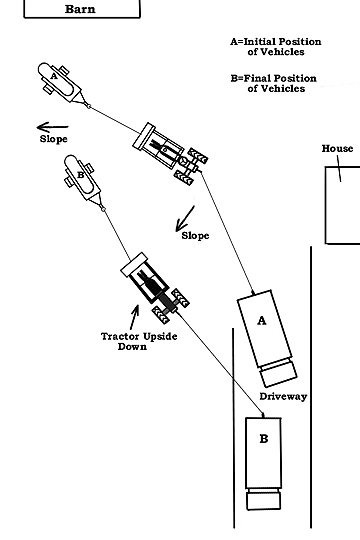
TO: Director, National Institute for Occupational Safety and Health
FROM: Iowa FACE Program ..................Submission Date: 1/12/2000
SUBJECT: Tractor operator was killed in an overturn while moving a sandblasting trailer.
 SUMMARY
SUMMARY During the winter of 1999 a man was killed while operating a narrow-front tractor at a rural business location in Iowa. The man was the owner of a sand blasting company and was in the process of moving a sandblasting trailer on his acreage. This homemade sandblasting trailer had previously been filled with sand by an employee who then parked the trailer in an undesirable location, slightly downhill from the main driveway. The trailer for the sandblaster had a high-mounted tongue, and the support jack for this trailer was in an extended position, therefore it was impossible to hook the trailer directly to the tractor draw bar. The man attached a chain from the trailer tongue to the front-end loader bucket. He lifted the tongue off the ground, then tried to back uphill with the tractor. The sand blasting trailer was full of sand and very heavy. It had snowed recently, and the victim was having difficulty getting sufficient traction while backing uphill in this position. Realizing he needed more pulling power, he attached a 50-foot chain from the tractor draw bar to the rear of a compressor truck used in the business. The man’s wife drove the truck, following hand signals from her husband. The truck was positioned on the entrance road to the acreage, slightly at an angle from the tractor and the sandblasting trailer. As they began to pull and move ahead, the truck turned slightly to its right down the driveway. This created a situation where the chains were pulling the tractor at an angle creating sideways forces at both attachment points. These forces caused the tractor to overturn to its left side, killing the operator underneath. The tractor did not have a Roll Over Protective Structure (ROPS).
RECOMMENDATIONS based on our investigation are as follows:
#1 To avoid overturns, operators of heavy equipment should pay special attention
to the attachment points and direction of pull while towing other equipment.
#2 All tractors should be equipped with Roll Over Protective Structures (ROPS).
#3 Narrow-front tractors (tricycle type) should not be equipped with front-end loaders.
INTRODUCTION
In January, 1999 the owner of a small sand blasting company was killed while trying to move a piece of equipment at his rural business / home acreage. The Iowa FACE program was notified of the fatality a few days later from a newspaper article, and began an investigation. Information was gathered from the County Sheriff, who also provided excellent photographs taken at the scene. Contact was made with the victim’s wife, and a site visit was planned for the summer. Two investigators from the Iowa FACE program conducted the site visit, talked with the victim’s wife, and took additional photographs and measurements at the scene. The tractor was not present during the investigation, since it had been sold to an auction company.
 The sand blasting company was a family business that was founded less than a year before the fatal overturn. The husband-wife team frequently used part-time help, but did not have any regular full-time employees. The couple had lived on their acreage for three years. The victim had over 30 years of sandblasting experience working with his father and with other companies. He had owned the tractor for one year, and was very familiar with the tractor and the sandblasting rig. There was no official safety program at this small business—part-time employees were instructed on a job-by-job basis. The sand blasting company was a continuous year-around business, and sandblasting was performed on location or at their rural shop location. The victim had several company vehicles and used several pieces of heavy equipment in his business. He was in the midst of preparing to sandblast several cement trucks.
The sand blasting company was a family business that was founded less than a year before the fatal overturn. The husband-wife team frequently used part-time help, but did not have any regular full-time employees. The couple had lived on their acreage for three years. The victim had over 30 years of sandblasting experience working with his father and with other companies. He had owned the tractor for one year, and was very familiar with the tractor and the sandblasting rig. There was no official safety program at this small business—part-time employees were instructed on a job-by-job basis. The sand blasting company was a continuous year-around business, and sandblasting was performed on location or at their rural shop location. The victim had several company vehicles and used several pieces of heavy equipment in his business. He was in the midst of preparing to sandblast several cement trucks. INVESTIGATION
The victim was attempting to move a heavy sandblasting trailer at his rural business location. The homemade trailer consisted of a large tank for sand, heavy-duty air handling hoses, filters, etc. It was made from a recycled anhydrous ammonia tank, and held three tons of sand when full. The single-axle trailer had dual tires and a pintel-type hitch for attachment to the rear of the compressor truck.
The victim and his wife had just returned from a vacation and were making preparations to sandblast several cement trucks. Three part-time employees had previously filled the tank with sand and parked the trailer on a sloping grassy area, slightly downhill from the main driveway. The normal place to store this trailer was in a shed, not in the open. These employees were not present that day, but the company owner was working by himself, assisted by his wife.
 It had recently snowed and there were snow drifts around the trailer, therefore the sloped area where the trailer was parked was quite slippery. Normally the trailer was moved using the compressor truck, but due to the slope and the weather, the victim did not want to risk getting the truck stuck in the snow. The height of the trailer tongue was about 0.75 meters (2’6"), which matched the compressor truck hitch point The tongue of the trailer was supported by a heavy-duty, screw-type jack. The tongue was not made to fit the tractor draw bar, and therefore the victim used the front-end loader to lift the tongue. The chain was attached to the midpoint of the bucket edge and to the trailer tongue (see Photo 2). To be able to support the tongue and its supporting jack in the air, the loader had to be raised quite high, approximately 1.2 m (4’) based on photographs from the scene after the injury.
It had recently snowed and there were snow drifts around the trailer, therefore the sloped area where the trailer was parked was quite slippery. Normally the trailer was moved using the compressor truck, but due to the slope and the weather, the victim did not want to risk getting the truck stuck in the snow. The height of the trailer tongue was about 0.75 meters (2’6"), which matched the compressor truck hitch point The tongue of the trailer was supported by a heavy-duty, screw-type jack. The tongue was not made to fit the tractor draw bar, and therefore the victim used the front-end loader to lift the tongue. The chain was attached to the midpoint of the bucket edge and to the trailer tongue (see Photo 2). To be able to support the tongue and its supporting jack in the air, the loader had to be raised quite high, approximately 1.2 m (4’) based on photographs from the scene after the injury. The tractor did not have sufficient weight and traction to pull the trailer up the slope on snowy ground. The added tongue weight to the front bucket, combined with the slope of the ground transferred weight off the rear wheels onto the narrow front-end of the tractor. There was a pile of sand on the ground where the tractor was sitting prior to the rollover. It appears the pile was formed from the rear wheels spinning backwards. Desiring more pull, the victim attached a 50-foot chain from the draw bar of the tractor to the rear of the compressor truck, which was positioned near the driveway heading towards the road. The tractor was an older tricycle-type model and did not have a ROPS to protect the operator.
When the victim’s wife returned from town, her husband asked her to assist him by driving the compressor truck. She was unable to communicate with him because of the noise, but relied on hand signals while looking through a side-view mirror. While they were pulling on the trailer and moving ahead, she turned the truck slightly to the right, more in line with the driveway, and then lost sight of her husband in the mirror. She then stopped the truck and looked out through the passenger window. The tractor had been pulled over to its left side, and had completely rolled over on its top (see Diagram), crushing her husband underneath. She went to him, but he was unresponsive. The man was air-lifted to a regional hospital where he was pronounced dead.
CAUSE OF DEATH
The official cause of death was listed as traumatic asphyxiation due to tractor rollover.
RECOMMENDATIONS / DISCUSSION
Recommendation #1 To avoid overturns, operators of heavy equipment should pay special attention to the attachment points and direction of pull while towing other equipment.
Discussion: Towing or pulling heavy equipment can become hazardous if the powered vehicle is pulling at an angle or if attachment points are high off the ground, thus increasing the risk of overturn. In this case the tractor front attachment point was the edge of the front-end loader (see Photo 2), which was approximately 1.2 m (4’) off the ground. Supporting the heavy trailer with the loader shifted some weight from the back wheels to the front wheels, which reduced the tractor’s pulling power and compromised stability due to the narrow front design. Initially the tractor and the sandblasting trailer were aligned, but after the truck started to pull and move down the driveway at an angle, significant sideways forces to the front and rear of the tractor were created. The combination of this changed angle, the tractor weight shifted to the front, the high front attachment point, narrow front wheels, and the sloping ground to the side of the tractor were accumulative factors sufficient to overturn the tractor to its left side. Even if visual communication between the two drivers was maintained, there would likely not have been sufficient time to react and prevent the sudden overturn. Pulling machinery at an angle should be avoided, and attachment points should be kept low, below or near axle level.
Recommendation #2 All tractors should be equipped with Roll Over Protective Structures (ROPS).
Discussion: ROPS are known to be nearly 100% effective in reducing deaths from tractor overturns. Tractors manufactured after 1986 have ROPS, but to date the majority of tractors in the United States do not yet have ROPS. Studies have suggested that risk factors for overturns include narrow front (tricycle design), using a front-end loader, and using the tractor for mowing on sloping ground. The tractor in this case was an old tricycle-type tractor equipped with a front-end loader. It is important that especially high-risk tractors that are used frequently are equipped with ROPS. In some cases ROPS are not available, but for the majority of functioning older tractors, such as this tractor, ROPS are available at fairly reasonable cost.
Recommendation #3 Narrow-front (tricycle type) tractors should not be equipped with front-end loaders.
Discussion: The combination of having a front-end loader on a tricycle type tractor has been found to be hazardous in previous FACE investigations. This type of tractor was common in the past, and many of these tractors are still in daily use. Tricycle-type tractors are more prone to overturns than wide-front tractors, and should not be used with front-end loaders or other attachments, which can significantly change the machine’s center of gravity. Raising or supporting a heavy load with the front-end loader bucket shifts weight from the back wheels to the narrow front wheels and decreases the tractor’s stability. Sideways forces from pulling, making sharp turns, or moving on uneven ground can easily cause an overturn.
_____________________________________________________________________
Wayne Johnson, M.D. Risto Rautiainen, M.Sc.Agr.
Trauma Investigator (FACE) Coordinator
Institute for Rural & Environmental Health Great Plains Center for Agricultural Health
University of Iowa -- Iowa City, Iowa Institute for Rural & Environmental Health
University of Iowa -- Iowa City, Iowa
*Photo credits: Thanks to the Shelby County Sheriff’s Office